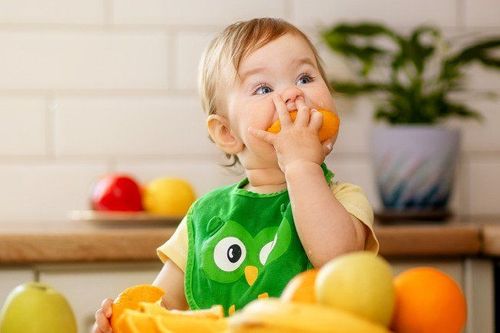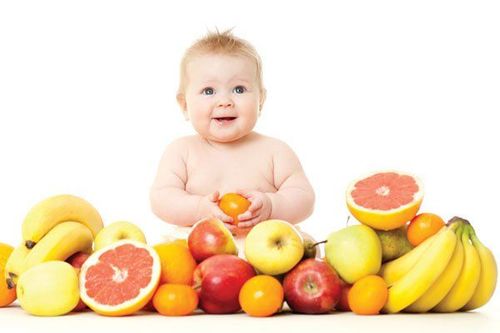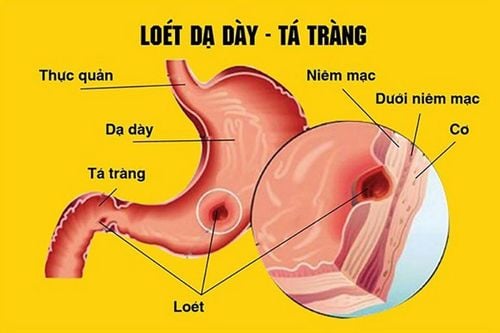Fruits are very good for health, not just for adults but also for children. Choosing the right time to eat fruits is crucial, as it affects the absorption of nutrients. So, when should children eat fruits, and how should they eat them properly?
Providing children with fruits daily is essential. However, there are specific points to note when giving fruits to children.
1. When should children eat fruits?
Infants should be exclusively breastfed for the first 6 months of life, as their digestive system is still immature and not ready for other types of food, including fruit smoothies or juices. You should introduce fruits to children when they are around 6 months old.
It is best to offer fruits 30-45 minutes after the main meal or as a separate snack about 2-3 hours before or after a main meal. Feeding fruits right before the main meal can fill the child up, making them refuse the main meal. On the other hand, giving fruits immediately after a meal may lead to indigestion, bloating, and even constipation.
Since fruits are rich in fructose, the ideal time for children to eat fruits is in the morning after a long night’s sleep. Eating fruits too close to bedtime can cause high blood sugar levels, potentially disrupting the child’s sleep.
Fruits are easily digested and converted into nutrients by the body, so it is a good idea to give them before meals, such as before breakfast or lunch.
After eating fruits, wait 1-2 hours to allow complete digestion before giving the child the next meal. This helps prevent bloating and ensures the stomach is ready for the next food intake.
Avoid giving fruits during main meals. Fruits should not be consumed with any other food. While vegetable and fruit salads are healthy, eating them with too many other types of food may slow down digestion. This also applies to fruit smoothies. Moreover, avoid mixing milk with fruit smoothies.
Fruits contain many nutrients, fiber, and healthy carbohydrates, which help keep the body energized throughout the day. Different fruits provide different nutrients, such as avocados, which are rich in vitamins K, B5, B6, and E, while bananas are high in potassium. Offering a variety of fruits ensures children absorb a wide range of essential nutrients.
Fruits provide fiber, vitamins, minerals, and antioxidants, reducing the risk of diabetes, heart disease, high cholesterol, and cancer. Compared to desserts like cakes or ice cream, fruits are a much healthier option after meals, as sugary desserts can increase the risk of obesity and heart disease.

2. How to Feed Fruits to Children Correctly?
First, introduce children to avocado and banana: Feeding fruits correctly means offering them in the right order. During the first 2-3 weeks of weaning, it is best to start with just two fruits—avocado and banana—because they are easy to digest and have a low risk of causing allergies. From weeks 4-5 of weaning (after 6.5 months of age), you can introduce a wider variety of fruits, such as apples, strawberries, mangoes, and dragon fruit, but it’s advisable to choose fruits with a mild sweetness.
How to give juice correctly: If you want to give fruit juice to your child, it should only be done under the guidance of a nutritionist—never give juice arbitrarily. You can offer juice during or after the main meal, or about 3 hours before a main meal, but avoid allowing the child to drink juice throughout the day.
Combining different fruits: Feeding fruits correctly also means knowing how to combine them appropriately. This helps prevent the child from developing a preference for a particular taste, keeps their palate balanced, and aids in better nutrient absorption.
Here are some fruit combination suggestions for parents: Avocado and banana; Papaya and mango; Apple and banana/pear; Avocado with apple/pear
Fruit combinations to avoid: Orange and carrot; Guava and banana; Pomegranate and apricot; Papaya and lemon
Seasonal fruits: Except for fruits available year-round, you should give children seasonal fruits and avoid off-season fruits. Off-season fruits are more likely to contain harmful substances, such as ripening chemicals, preservatives, or higher levels of pesticide residues compared to seasonal fruits.

In some cases, if a child has digestive issues, it’s important to adjust how they eat fruits to ensure optimal nutrition.
If the child’s digestive system is sensitive, the fructose found in fruits may be difficult to digest. When fruits are eaten together with or close to main meals, this sugar can draw water into the intestines, leading to bloating. In such cases, fruits should be given during snack times (morning or afternoon) between main meals, without necessarily having to eat them before meals.
If the child has a weak or compromised digestive system, the fiber in fruits may also cause bloating. Once again, it’s best to offer fruits at a time distant from main meals.
Fruits are very beneficial for the health of both children and adults. However, fruits should not be offered at all times. Eating at the right time and in the right way will bring the most health and developmental benefits for young children.
Please dial HOTLINE for more information or register for an appointment HERE. Download MyVinmec app to make appointments faster and to manage your bookings easily.
To arrange an appointment, please call HOTLINE or make your reservation directly HERE. You may also download the MyVinmec app to schedule appointments faster and manage your reservations more conveniently.








